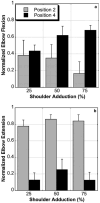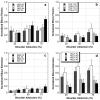Position-dependent torque coupling and associated muscle activation in the hemiparetic upper extremity
- PMID: 16924488
- PMCID: PMC2827933
- DOI: 10.1007/s00221-006-0637-x
Position-dependent torque coupling and associated muscle activation in the hemiparetic upper extremity
Abstract
Previous studies have demonstrated abnormal joint torque coupling and associated muscle coactivations of the upper extremity in individuals with unilateral stroke. We investigated the effect of upper limb configuration on the expression of the well-documented patterns of shoulder abduction/elbow flexion and shoulder adduction/elbow extension. Maximal isometric shoulder and elbow torques were measured in stroke subjects in four different arm configurations. Additionally, an isometric combined torque task was completed where subjects were required to maintain various levels of shoulder abduction/adduction torque while attempting to maximize elbow flexion or extension torque. The dominant abduction/elbow flexion pattern was insensitive to changes in limb configuration while the elbow extension component of the adduction/extension pattern changed to elbow flexion at smaller shoulder abduction angles. This effect was not present in control subjects without stroke. The reversal of the torque-coupling pattern could not be explained by mechanical factors such as muscle length changes or muscle strength imbalances across the elbow joint. Potential neural mechanisms underlying the sensitivity of the adduction/elbow extension pattern to different somatosensory input resultant from changes in limb configuration are discussed along with the implications for future research.
Figures




Similar articles
-
Differences between flexion and extension synergy-driven coupling at the elbow, wrist, and fingers of individuals with chronic hemiparetic stroke.Clin Neurophysiol. 2019 Apr;130(4):454-468. doi: 10.1016/j.clinph.2019.01.010. Epub 2019 Jan 31. Clin Neurophysiol. 2019. PMID: 30771722 Free PMC article.
-
Control of double-joint arm posture in adults with unilateral brain damage.Exp Brain Res. 2005 Jun;163(4):468-86. doi: 10.1007/s00221-004-2202-9. Epub 2005 Feb 3. Exp Brain Res. 2005. PMID: 15690154
-
Modifiability of abnormal isometric elbow and shoulder joint torque coupling after stroke.Muscle Nerve. 2005 Aug;32(2):170-8. doi: 10.1002/mus.20343. Muscle Nerve. 2005. PMID: 15880629 Free PMC article. Clinical Trial.
-
Neck rotation modulates flexion synergy torques, indicating an ipsilateral reticulospinal source for impairment in stroke.J Neurophysiol. 2012 Dec;108(11):3096-104. doi: 10.1152/jn.01030.2011. Epub 2012 Sep 5. J Neurophysiol. 2012. PMID: 22956793 Free PMC article.
-
Torque steadiness and muscle activation are bilaterally impaired during shoulder abduction and flexion in chronic post-stroke subjects.J Electromyogr Kinesiol. 2016 Oct;30:151-60. doi: 10.1016/j.jelekin.2016.07.003. Epub 2016 Jul 6. J Electromyogr Kinesiol. 2016. PMID: 27451360
Cited by
-
Differences between flexion and extension synergy-driven coupling at the elbow, wrist, and fingers of individuals with chronic hemiparetic stroke.Clin Neurophysiol. 2019 Apr;130(4):454-468. doi: 10.1016/j.clinph.2019.01.010. Epub 2019 Jan 31. Clin Neurophysiol. 2019. PMID: 30771722 Free PMC article.
-
Neuromodulatory Inputs to Motoneurons Contribute to the Loss of Independent Joint Control in Chronic Moderate to Severe Hemiparetic Stroke.Front Neurol. 2018 Jun 21;9:470. doi: 10.3389/fneur.2018.00470. eCollection 2018. Front Neurol. 2018. PMID: 29977224 Free PMC article.
-
Activity-Based Therapies for Repair of the Corticospinal System Injured during Development.Front Neurol. 2014 Nov 24;5:229. doi: 10.3389/fneur.2014.00229. eCollection 2014. Front Neurol. 2014. PMID: 25505443 Free PMC article. Review.
-
Spatial mapping of posture-dependent resistance to passive displacement of the hypertonic arm post-stroke.J Neuroeng Rehabil. 2023 Dec 1;20(1):163. doi: 10.1186/s12984-023-01285-7. J Neuroeng Rehabil. 2023. PMID: 38041164 Free PMC article.
-
A pilot study into reaching performance after severe to moderate stroke using upper arm support.PLoS One. 2018 Jul 17;13(7):e0200787. doi: 10.1371/journal.pone.0200787. eCollection 2018. PLoS One. 2018. PMID: 30016364 Free PMC article.
References
-
- Adamovich SV, Archambault PS, Ghafouri M, Levin MF, Poizner H, Feldman AG. Hand trajectory invariance in reaching movements involving the trunk. Exp Brain Res. 2001;138:288–303. - PubMed
-
- Alvarez FJ, Pearson JC, Harrington D, Dewey D, Torbeck L, Fyffe RE. Distribution of 5-hydroxytryptamine-immunoreactive boutons on alpha-motoneurons in the lumbar spinal cord of adult cats. J Comp Neurol. 1998;393:69–83. - PubMed
-
- Baldissera F, Cavallari P, Tassone G. Effects of transmastoid electrical stimulation on the triceps brachii EMG in man. Neuroreport. 1990;1:191–193. - PubMed
-
- Beer RF, Given JD, Dewald JP. Task-dependent weakness at the elbow in patients with hemiparesis. Arch Phys Med Rehabil. 1999;80:766–772. - PubMed
-
- Beer RF, Dewald JP, Rymer WZ. Deficits in the coordination of multijoint arm movements in patients with hemiparesis: evidence for disturbed control of limb dynamics. Exp Brain Res. 2000;131:305–319. - PubMed
Publication types
MeSH terms
Grants and funding
LinkOut - more resources
Full Text Sources
Medical

